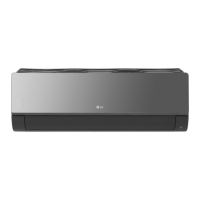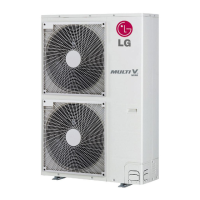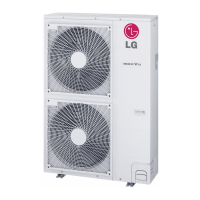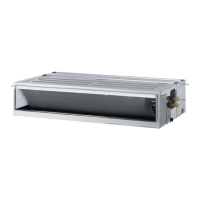54
Multi V Wall-Mounted Indoor Unit
Due to our policy of continuous product innovation, some specifications may change without notification.
©LG Electronics U.S.A., Inc., Englewood Cliffs, NJ. All rights reserved. “LG” is a registered trademark of LG Corp.
Piping Bundling
Gallery and wall-mounted indoor units allow for piping
bundling. See the Figure on the right for proper pipe and
cable bundling. Note the placement of the piping along
with the necessary insulation material.
1. Wrap each pipe with proper insulation material.
2. Secure the piping by wrapping vinyl tape around the
pipe. Use the narrow size tape for wrapping the actual
pipe.
3. Drain hose can be included within the bundled piping.
Wrap all of them together using the wider vinyl tape as
shown. The end of the drain hose outlet must be routed
above the ground.
Vinyl Tape (Narrow)
Wrap with Vinyl Tape
Drain Hose
Pipe
Vinyl Tape (Wide)
Vinyl Tape (Narrow)
Connection
Cable
Drain Hose
Connecting
Cable
Gas Piping
Liquid Piping
Drain Hose
Note:
• If the drain hose is routed inside the room, insulate the hose with insulation material so that dripping
condensation will not damage walls, floors, or furniture.
• Make sure the drain hose is positioned at the lowest side of the bundle. Positioning the drain hose at
the top can cause the drain pan to overflow inside the indoor unit.
Figure 66: Close Up of Bundling and
Taping.
Figure 67: Example of Bundling
Gallery Indoor Unit Piping, Drain
Hose, and Connecting Cable.
REFRIGERANT PIPING CONNECTIONS
Insulating the Piping
Sufficiently insulate all cold surfaces to prevent moisture forming. All pipes must be insulated and each pipe must be separately wrapped.
Use field-provided one-half (1/2) inch thick (or thicker) closed-cell insulation. The thickness may need to be increased based on ambient
conditions and local codes.
Wrap all refrigerant piping including field-provided isolation ball valves and flexible pipe connection kits provided by LG. Glue all insulation
joints with no air gaps between insulation segments, and between insulation segments and the unit case. Ensure insulation material fits
snugly against the refrigeration pipe with no air space between the pipe surface and the surrounding insulation.
Protect insulation inside hangers and supports with a second insulation layer. Ensure insulation on all pipe passing through pipe hangers,
inside conduit, and/or sleeves is not compressed.

